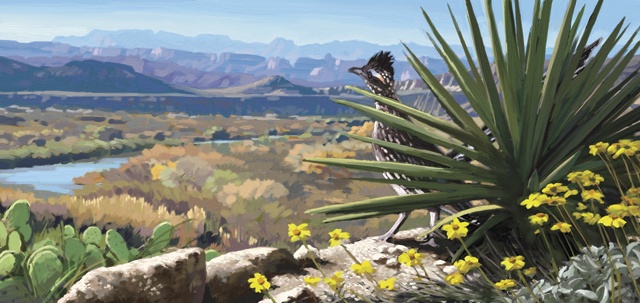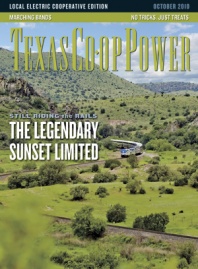Sunrise splatters like fiery orange paint over the Wylie Mountains east of Van Horn. For just a second, I stare directly into the blinding rays. Foolish decision. My eyes water and burn, and I fumble around in the console of the rental car, finding and shoving my sunglasses into place.
It’s too early to think clearly, too late to dawdle. I’ve got a plane to catch in Midland some 175 miles away. I reach for my McDonald’s breakfast. Grateful for those golden arches, I equally resent this cultural icon that represents a bridge back to my urbanized life.
Just like that, after three days of trolling the back roads of far West Texas, sometimes driving an hour or two without seeing another soul, I’m eating fast food in the interstate’s fast lane where the 18-wheelers never slow down.
Don’t let it be time to go home. Not just yet. I’d like my morning cooked over easy, please, with a side of tranquility. Let me savor the mountains and desert a little longer before I return to the city with its snarled traffic and sky-blocking condos.
I’m not the first person to fall in love with West Texas and dream of someday living out here. Bill Wren, special assistant to the superintendent at McDonald Observatory, moved to the Fort Davis area 20 years ago from Austin. This astronomer is easily at home in the Davis Mountains that seem to hold the stars in place.
But West Texas isn’t for everybody. “Some people go batty,” Wren says, bluntly. “They can’t handle the solitude.”
I’ll be the first to admit that there’s comfort in the cacophony of the city. In West Texas’ most remote spots, the loudest thing you’ll hear is the ringing in your ears. Cell phone service is spotty, at best. And hitting the radio’s seek button will simply spin the call numbers around and around.
Still, I lose myself out here, like a snake shedding its skin. As I repeatedly pull over to soak up the view—impossibly blue skies, bluish mountains rolling in like waves—I imagine my worried thoughts emptying into a bucket beside me. I feel the external landscape smoothing out the bumps in my internal one. I can relax and admire the cactus without feeling so prickly myself.
I’ve made six trips to West Texas since August 2009. If you plotted my travels on a map, they would look like the wanderings of an inebriated roadrunner—my adopted West Texas mascot. No matter where I go, it seems the curious roadrunner is there as an omniscient observer signaling what’s about to unfold.
In summer 2009, on my first-ever hike at Big Bend National Park, my companion and I came upon a warning sign: A mountain lion was frequenting the Chisos Basin. We clutched handfuls of small rocks, ready to fend off a big, dangerous cat.
We soon had company: a roadrunner who stayed just ahead of us on the trail, disappearing into the brush and re-emerging, almost as if he were checking on us. I knew he was hunting supper and didn’t care whether we were eaten by a mountain lion. But I felt safer.
The roadrunner’s road leads everywhere. My road, it seems, always leads to Marathon, the gateway to Big Bend. I almost know the road, U.S. 385, by heart as it drops down from Fort Stockton and into the Glass Mountains.
And then, it’s a right turn onto U.S. 90 and into “Mara-thun,” as the locals pronounce it. One afternoon in February, the wooden doors to St. Mary’s Catholic Church were unlocked. I slipped inside and lit a candle in memory of a friend who’d died six months earlier. Then, I strolled the sidewalk alongside U.S. 90 and ran into photographer James Evans outside his gallery. He was in a hurry. No time to talk. But he saw the disappointment on my face and softened. Come on in, he said, unlocking the door. I’ve got a few minutes.
I learned that Evans moved here from Austin 21 years ago to spend the rest of his life photographing the Big Bend region. He still shoots film and is rarely in the gallery because he’s outdoors chasing the perfect light. His theory on what makes Marathon so special—“It’s not trying to be anything”—easily sums up all of West Texas.
My mind was full, but not painfully so, as I sat down for supper at the Famous Burro restaurant. While waiting on my food, I made a cell phone call. Then I found myself chatting with the married couple sharing my table: Susanna and Don Fuéntez, childhood sweethearts who graduated from Marathon High School in 1965.
Susanna smiled warmly. “Are you just passing through?” Yes, I said, explaining I was headed to Marfa that night and ultimately back home to Austin. She said she couldn’t help but overhear my phone conversation about my afternoon in Marathon. “Are you Catholic?” she asked. No, I said, I just feel at peace in that little church.
The three of us laughed and talked the evening away. Two and a half days later, I was leaving Van Horn, my final stop, and headed home, trying to keep thoughts in my bucket and out of my head. Outside Pecos, I saw a coyote looking lost in the median. He sniffed the air, oblivious to the traffic rushing past him.
With a lump in my throat, I watched the mountains grow smaller in the rearview mirror. The land straightened out, and I settled into the pace of the interstate.
——————–
Camille Wheeler is staff writer for Texas Co-op Power.


